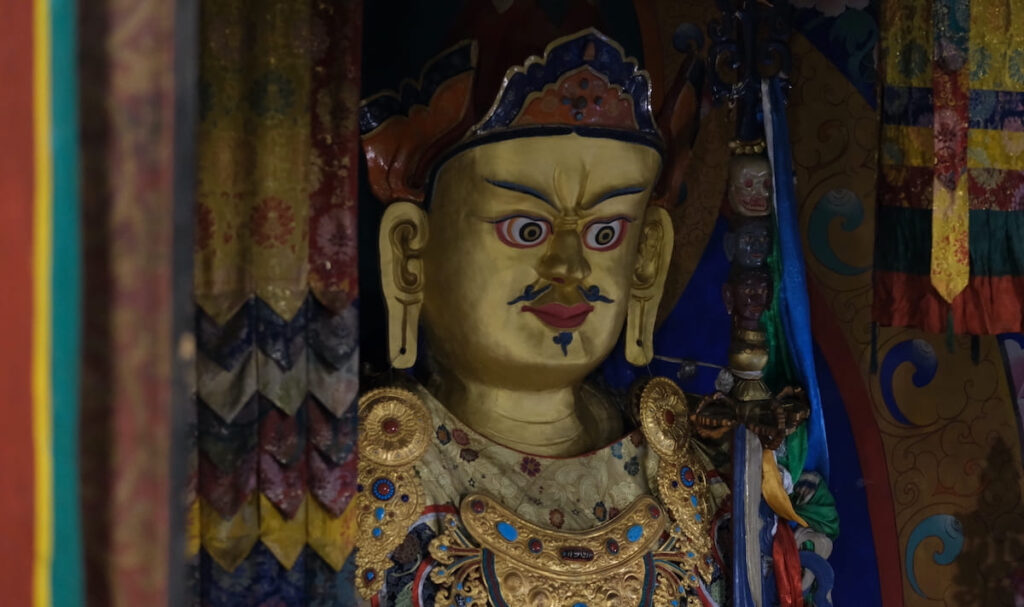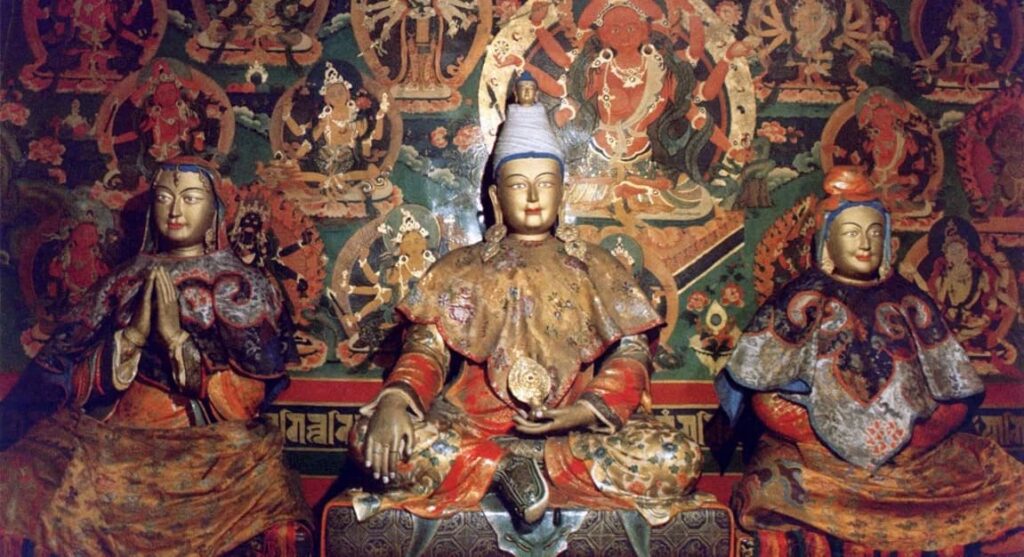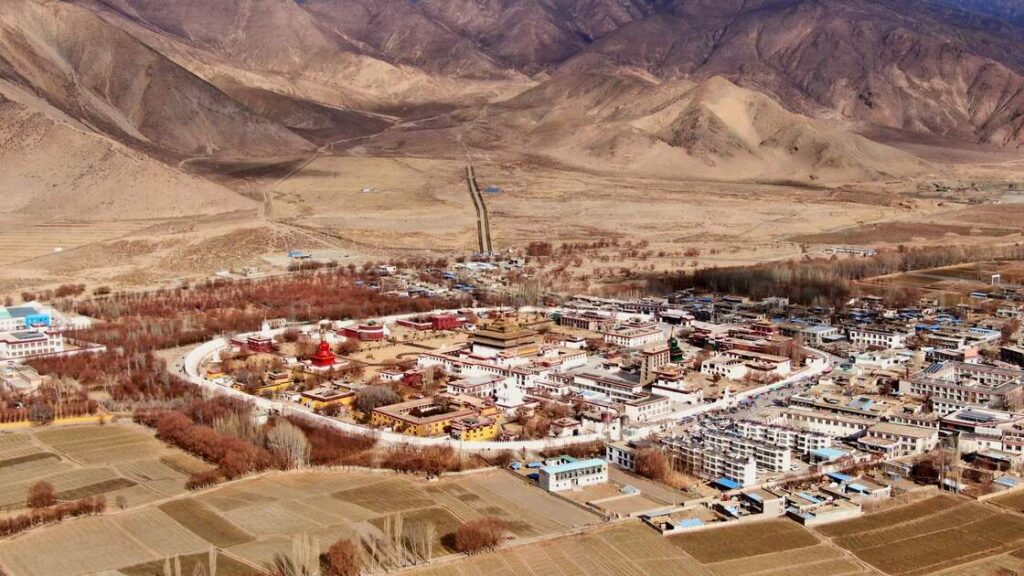+86-15889090408
[email protected]
In the vast and profound history of Tibetan Buddhism, few figures have had such an enduring influence as Guru Padmasambhava, also known as Guru Rinpoche. Revered as one of the most important figures in the establishment of Tibetan Buddhism, Guru Padmasambhava is considered the spiritual father of the Nyingma school, one of the oldest schools of the Tibetan Buddhist tradition. His contributions to Tibetan religion, culture, and the practice of Buddhism are unparalleled, and his legacy continues to shape the spiritual practices of millions of Tibetan Buddhists around the world.

This article will delve into the life and teachings of Guru Padmasambhava, exploring his journey to Tibet, his role in the spread of Buddhism in Tibet, and how his influence continues to guide Tibetan Buddhist culture today. We will explore how Guru Padmasambhava’s teachings have left an indelible mark on Tibetan Buddhist culture, and why his spiritual presence is still felt deeply in the monasteries and sacred sites of Tibet.
Guru Padmasambhava, often called Padmasambhava (meaning “Lotus-Born”), was an Indian Buddhist master who lived during the 8th century. His name signifies his miraculous birth from a lotus flower in a lake in Uddiyana, which is believed to be located in the present-day regions of Pakistan or northern India. Born in a time of profound spiritual awakening, Padmasambhava was a great scholar, practitioner, and teacher of Tantric Buddhism. His teachings helped shape the form of Buddhism that would come to flourish in Tibet, making him one of the most revered figures in Tibetan Buddhist culture.
Padmasambhava is not just considered a historical figure but also a deeply spiritual being who has left a profound legacy in the hearts of his followers. His influence extended far beyond his physical presence in Tibet. His role in establishing Buddhism in Tibet, especially Tantric Buddhism, marks him as one of the principal figures in Tibetan history. He is also often depicted as a Buddha-like figure who symbolizes the spiritual guidance and inner strength required for personal and collective enlightenment.
The arrival of Padmasambhava in Tibet was not merely a matter of migration or travel; it was the beginning of an extraordinary spiritual mission that would transform Tibetan religion and culture forever. Padmasambhava’s journey is deeply intertwined with the establishment of Buddhism in Tibet, and it is told in various texts and oral traditions.
In the 8th century, King Trisong Detsen of Tibet faced resistance from the indigenous Bon religion, which held sway in the region long before Buddhism’s arrival. Trisong Detsen had already invited the Indian scholar Shantarakshita to Tibet, but the resistance of the Bonpo and other forces made the establishment of Buddhism difficult. In 749 AD, Trisong Detsen decided to invite Padmasambhava to Tibet in hopes that he would help overcome these obstacles.
Padmasambhava’s arrival in Tibet marked the beginning of the Second Diffusion of Buddhism (or “The Revival of Buddhism”), which was crucial in establishing Tibetan Buddhism as a central part of Tibetan life. As an accomplished Tantric master, Padmasambhava’s unique understanding of Buddhist practices enabled him to confront spiritual forces and obstacles, helping to pave the way for Buddhism to take root in Tibet.

Padmasambhava is particularly known for his Tantric practices, which were essential in making Buddhism accessible to the Tibetan people. He is believed to have been instrumental in spreading Vajrayana Buddhism, a form of Tibetan Buddhism that incorporates esoteric teachings, mantras, rituals, and meditation techniques. Vajrayana emphasizes the importance of both wisdom and compassion in the path to enlightenment and requires rigorous spiritual practices to master the profound teachings of Buddha.
When Guru Padmasambhava arrived in Tibet, he initiated the construction of the first Buddhist monastery, Samye Monastery, and established it as a center for the study and practice of Buddhism. The monastery’s layout was designed as a Mandala, symbolizing the universe, and it soon became a central location for Tibetan Buddhist monks and practitioners.
Through Padmasambhava’s teachings and practices, Tibetan Buddhists learned to integrate Tantric Buddhism into their lives and develop a deeper understanding of the Buddhist path to enlightenment. His teachings also emphasized the importance of meditation, visualization, and the guru-disciple relationship, all of which are still core components of Tibetan Buddhist culture today.
Guru Padmasambhava is often regarded as the most important figure in the establishment of Buddhism in Tibet. While Buddhism had been introduced to Tibet in the 7th century through King Songtsen Gampo, it was Padmasambhava who ensured that Buddhism became a central part of Tibetan religion and culture, especially through his role in overcoming resistance from Bonpo traditions.
Padmasambhava’s most significant role in spreading Buddhism was his ability to subjugate the local spirits and deities who were opposed to the new religion. The Bon religion believed in a host of deities and spirits that were often at odds with the teachings of Buddhism. According to Tibetan traditions, Padmasambhava did not destroy these spirits but rather converted them into protectors of Buddhism, a practice known as “pacifying” the local deities.
One of Padmasambhava’s most famous legends involves his encounter with the demonic forces that were obstructing the construction of the Samye Monastery. He is said to have used his profound wisdom and mystical powers to subdue these forces, turning them into protectors of the Dharma. This act of converting local deities into Buddhist protectors played a crucial role in the peaceful integration of Buddhism into Tibetan society.

Padmasambhava’s teachings were highly esoteric and contained deep, secret practices that he imparted to his disciples. He is said to have taught the Vajrayana, or Tantric Buddhism, which focuses on the use of mantras, meditation, and visualization to accelerate the path to enlightenment. This form of Buddhism emphasized the direct experience of ultimate reality, and many of Padmasambhava’s practices are still used by Tibetan Buddhists today.
Padmasambhava left behind a rich legacy of texts and oral traditions, including teachings on the Dzogchen path (the “Great Perfection”), which is considered one of the highest teachings in Tibetan Buddhism. His esoteric teachings helped shape the formation of the Nyingma school of Tibetan Buddhism, which is still one of the primary schools practiced today.
Guru Padmasambhava’s legacy is firmly rooted in Tibetan Buddhist culture. His presence is deeply felt not only in the teachings and practices of Tibetan Buddhism but also in the rich cultural expressions and rituals that accompany it. The Nyingma school, founded by Padmasambhava, has had a profound influence on the overall development of Tibetan Buddhism, especially in the realms of meditation, ritual, and spiritual understanding.
Padmasambhava is often depicted in Tibetan Buddhist art and iconography in a variety of forms, each symbolizing different aspects of his teachings. Common depictions of Guru Padmasambhava show him seated in a meditative posture, holding a vajra (a symbol of indestructibility), and sometimes accompanied by a skullcup (representing the transmutation of negative emotions into wisdom).
In Tibetan monasteries, Padmasambhava is honored with rituals, prayers, and festivals. The Padmasambhava Day, which falls on the 10th day of the 6th month of the Tibetan lunar calendar, is dedicated to his birth and teachings. On this day, Tibetan Buddhists celebrate his life and pay homage to the great master through prayers, offerings, and chants.
Guru Padmasambhava is also considered the guardian of many sacred sites across Tibet, and his influence can be seen in many of Tibet’s holy places. His teachings continue to guide Tibetan Buddhists through practices such as Guru Yoga, where practitioners meditate on the Guru as a means to connect with the enlightened qualities of the teacher.
Today, Guru Padmasambhava remains an essential figure in Tibetan Buddhism. His teachings, practices, and iconography are not just relics of history but active parts of the living tradition. Many Tibetan Buddhist practitioners continue to seek his guidance through meditation and prayer, and his presence is considered vital in helping practitioners overcome obstacles on the path to enlightenment.
Guru Padmasambhava’s legacy also reaches beyond Tibet. His influence can be seen in Tibetan Buddhist communities around the world, including those in India, Nepal, Bhutan, and the West. His teachings on compassion, wisdom, and spiritual power continue to inspire modern practitioners of Tibetan Buddhism, making his contributions relevant to contemporary Buddhism.
Guru Padmasambhava, the Lotus-Born, is one of the most important figures in the history of Tibetan Buddhism. His journey to Tibet and his subsequent teachings laid the foundation for the flourishing of Buddhism in Tibet, especially in the form of Tantric and Vajrayana practices. His ability to integrate the indigenous Bon religion with Buddhism and his spiritual influence in shaping Tibetan Buddhist culture continues to resonate across centuries. Whether through his teachings on Dzogchen, his role in the founding of the Nyingma school, or his ability to pacify local spirits, Guru Padmasambhava’s contributions have shaped Tibetan Buddhist religion and culture for generations.
Today, his teachings continue to inspire and guide millions of Tibetan Buddhists across the globe, securing his place as one of the most revered and influential figures in the history of Tibetan Buddhism.


In the vast and profound history of Tibetan Buddhism, few figures have had such an enduring influence as Guru Padmasambhava, also known as Guru Rinpoche. Revered as one of the most important figures in the establishment of Tibetan Buddhism, Guru Padmasambhava is considered the spiritual father of the Nyingma school, one of the oldest schools of the Tibetan Buddhist tradition. His contributions to Tibetan religion, culture, and the practice of Buddhism are unparalleled, and his legacy continues to shape the spiritual practices of millions of Tibetan Buddhists around the world.

This article will delve into the life and teachings of Guru Padmasambhava, exploring his journey to Tibet, his role in the spread of Buddhism in Tibet, and how his influence continues to guide Tibetan Buddhist culture today. We will explore how Guru Padmasambhava’s teachings have left an indelible mark on Tibetan Buddhist culture, and why his spiritual presence is still felt deeply in the monasteries and sacred sites of Tibet.
Guru Padmasambhava, often called Padmasambhava (meaning “Lotus-Born”), was an Indian Buddhist master who lived during the 8th century. His name signifies his miraculous birth from a lotus flower in a lake in Uddiyana, which is believed to be located in the present-day regions of Pakistan or northern India. Born in a time of profound spiritual awakening, Padmasambhava was a great scholar, practitioner, and teacher of Tantric Buddhism. His teachings helped shape the form of Buddhism that would come to flourish in Tibet, making him one of the most revered figures in Tibetan Buddhist culture.
Padmasambhava is not just considered a historical figure but also a deeply spiritual being who has left a profound legacy in the hearts of his followers. His influence extended far beyond his physical presence in Tibet. His role in establishing Buddhism in Tibet, especially Tantric Buddhism, marks him as one of the principal figures in Tibetan history. He is also often depicted as a Buddha-like figure who symbolizes the spiritual guidance and inner strength required for personal and collective enlightenment.
The arrival of Padmasambhava in Tibet was not merely a matter of migration or travel; it was the beginning of an extraordinary spiritual mission that would transform Tibetan religion and culture forever. Padmasambhava’s journey is deeply intertwined with the establishment of Buddhism in Tibet, and it is told in various texts and oral traditions.
In the 8th century, King Trisong Detsen of Tibet faced resistance from the indigenous Bon religion, which held sway in the region long before Buddhism’s arrival. Trisong Detsen had already invited the Indian scholar Shantarakshita to Tibet, but the resistance of the Bonpo and other forces made the establishment of Buddhism difficult. In 749 AD, Trisong Detsen decided to invite Padmasambhava to Tibet in hopes that he would help overcome these obstacles.
Padmasambhava’s arrival in Tibet marked the beginning of the Second Diffusion of Buddhism (or “The Revival of Buddhism”), which was crucial in establishing Tibetan Buddhism as a central part of Tibetan life. As an accomplished Tantric master, Padmasambhava’s unique understanding of Buddhist practices enabled him to confront spiritual forces and obstacles, helping to pave the way for Buddhism to take root in Tibet.

Padmasambhava is particularly known for his Tantric practices, which were essential in making Buddhism accessible to the Tibetan people. He is believed to have been instrumental in spreading Vajrayana Buddhism, a form of Tibetan Buddhism that incorporates esoteric teachings, mantras, rituals, and meditation techniques. Vajrayana emphasizes the importance of both wisdom and compassion in the path to enlightenment and requires rigorous spiritual practices to master the profound teachings of Buddha.
When Guru Padmasambhava arrived in Tibet, he initiated the construction of the first Buddhist monastery, Samye Monastery, and established it as a center for the study and practice of Buddhism. The monastery’s layout was designed as a Mandala, symbolizing the universe, and it soon became a central location for Tibetan Buddhist monks and practitioners.
Through Padmasambhava’s teachings and practices, Tibetan Buddhists learned to integrate Tantric Buddhism into their lives and develop a deeper understanding of the Buddhist path to enlightenment. His teachings also emphasized the importance of meditation, visualization, and the guru-disciple relationship, all of which are still core components of Tibetan Buddhist culture today.
Guru Padmasambhava is often regarded as the most important figure in the establishment of Buddhism in Tibet. While Buddhism had been introduced to Tibet in the 7th century through King Songtsen Gampo, it was Padmasambhava who ensured that Buddhism became a central part of Tibetan religion and culture, especially through his role in overcoming resistance from Bonpo traditions.
Padmasambhava’s most significant role in spreading Buddhism was his ability to subjugate the local spirits and deities who were opposed to the new religion. The Bon religion believed in a host of deities and spirits that were often at odds with the teachings of Buddhism. According to Tibetan traditions, Padmasambhava did not destroy these spirits but rather converted them into protectors of Buddhism, a practice known as “pacifying” the local deities.
One of Padmasambhava’s most famous legends involves his encounter with the demonic forces that were obstructing the construction of the Samye Monastery. He is said to have used his profound wisdom and mystical powers to subdue these forces, turning them into protectors of the Dharma. This act of converting local deities into Buddhist protectors played a crucial role in the peaceful integration of Buddhism into Tibetan society.

Padmasambhava’s teachings were highly esoteric and contained deep, secret practices that he imparted to his disciples. He is said to have taught the Vajrayana, or Tantric Buddhism, which focuses on the use of mantras, meditation, and visualization to accelerate the path to enlightenment. This form of Buddhism emphasized the direct experience of ultimate reality, and many of Padmasambhava’s practices are still used by Tibetan Buddhists today.
Padmasambhava left behind a rich legacy of texts and oral traditions, including teachings on the Dzogchen path (the “Great Perfection”), which is considered one of the highest teachings in Tibetan Buddhism. His esoteric teachings helped shape the formation of the Nyingma school of Tibetan Buddhism, which is still one of the primary schools practiced today.
Guru Padmasambhava’s legacy is firmly rooted in Tibetan Buddhist culture. His presence is deeply felt not only in the teachings and practices of Tibetan Buddhism but also in the rich cultural expressions and rituals that accompany it. The Nyingma school, founded by Padmasambhava, has had a profound influence on the overall development of Tibetan Buddhism, especially in the realms of meditation, ritual, and spiritual understanding.
Padmasambhava is often depicted in Tibetan Buddhist art and iconography in a variety of forms, each symbolizing different aspects of his teachings. Common depictions of Guru Padmasambhava show him seated in a meditative posture, holding a vajra (a symbol of indestructibility), and sometimes accompanied by a skullcup (representing the transmutation of negative emotions into wisdom).
In Tibetan monasteries, Padmasambhava is honored with rituals, prayers, and festivals. The Padmasambhava Day, which falls on the 10th day of the 6th month of the Tibetan lunar calendar, is dedicated to his birth and teachings. On this day, Tibetan Buddhists celebrate his life and pay homage to the great master through prayers, offerings, and chants.
Guru Padmasambhava is also considered the guardian of many sacred sites across Tibet, and his influence can be seen in many of Tibet’s holy places. His teachings continue to guide Tibetan Buddhists through practices such as Guru Yoga, where practitioners meditate on the Guru as a means to connect with the enlightened qualities of the teacher.
Today, Guru Padmasambhava remains an essential figure in Tibetan Buddhism. His teachings, practices, and iconography are not just relics of history but active parts of the living tradition. Many Tibetan Buddhist practitioners continue to seek his guidance through meditation and prayer, and his presence is considered vital in helping practitioners overcome obstacles on the path to enlightenment.
Guru Padmasambhava’s legacy also reaches beyond Tibet. His influence can be seen in Tibetan Buddhist communities around the world, including those in India, Nepal, Bhutan, and the West. His teachings on compassion, wisdom, and spiritual power continue to inspire modern practitioners of Tibetan Buddhism, making his contributions relevant to contemporary Buddhism.
Guru Padmasambhava, the Lotus-Born, is one of the most important figures in the history of Tibetan Buddhism. His journey to Tibet and his subsequent teachings laid the foundation for the flourishing of Buddhism in Tibet, especially in the form of Tantric and Vajrayana practices. His ability to integrate the indigenous Bon religion with Buddhism and his spiritual influence in shaping Tibetan Buddhist culture continues to resonate across centuries. Whether through his teachings on Dzogchen, his role in the founding of the Nyingma school, or his ability to pacify local spirits, Guru Padmasambhava’s contributions have shaped Tibetan Buddhist religion and culture for generations.
Today, his teachings continue to inspire and guide millions of Tibetan Buddhists across the globe, securing his place as one of the most revered and influential figures in the history of Tibetan Buddhism.

